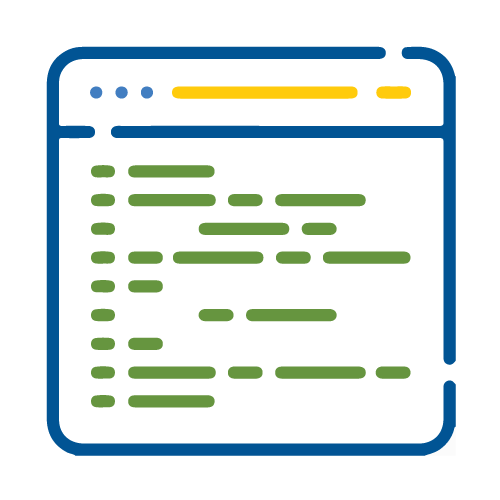Curated by: Sergio A. Martínez
With the need to be more environmentally focused every day, we look at an approach to software development that can help our industry utilize its resources better and more efficiently: Green Coding.

When it comes to good practices in software development, there’s more to it than just efficiency and delivery of results during every sprint; there’s also a lot to consider about the impact caused by the products we make, both for our clients, final users, and the world at large.
After all, we all know that software development can be a resource-intensive process. First, it generally requires a significant amount of development time to create robust and efficient applications. And second, developing software often requires the use of multiple tools and technologies, which can add to the cost of development. However, beyond these normal cases of resource investment from any software development company, what many people don’t realize is that coding can have a significant impact on the environment. After all, software development has always been a complex and time-consuming process, but in recent years this process has come into sharp focus, as the effects of global warming (and the time we have left to mitigate its effects) have become more and more pressing.
In the case of technology, the creation of new software often requires the use of powerful machines, which consume large amounts of energy, and generate considerable amounts of heat and noise, in addition to the involvement of dozens or even hundreds of software development tools, each of which has a footprint. As a result, the environmental impact of software development can be significant.
Fortunately, there are several ways to reduce the environmental impact of software development, like using more efficient development tools that consume less energy or developing software in collaboration with other developers, which can help to reduce the overall number of development tools in use. However, all this could be for naught if our approach to software development doesn’t include a responsible mindset, which is the origin of a new way to approach the creation of new applications: Green Coding.
Green Coding: Efficiency in balance

By taking these steps, developers can help to protect the environment while still creating high-quality software products, which is why more and more companies are adopting “Green Coding” practices. Green Coding is all about developing software in a way that minimizes its environmental impact, and that means anything from using energy-efficient hardware to writing code that is easier to recycle or reuse.
There are a lot of reasons why green coding is becoming a necessary practice in the software industry. For one, it’s simply the right thing to do: we have a responsibility to take care of our planet, and Green Coding is one way we can make a difference. But there are also practical reasons for adopting these practices; energy-efficient hardware, for example, can save developers money on their electric bills (an essential concern in remote setups), and code that is easier to reuse can save time and resources in the long run. So no matter what your motivation is, there are plenty of ways to go, so let’s review some techniques to ensure your code is as environment-friendly as possible.
- Efficient writing: Before going into coding itself, let’s take a step back and think about the physical tool you use to write: your keyboard. How much energy does your keyboard spend during the day? Although the amount might seem negligible (around 1W per hour on average, maybe even less), most USB keyboards increase around 5 times the amount of energy they consume the older they get, depending on their build type and brand. And going along with the energy used by the whole computer setup, this energy adds up, which is why using wireless, rechargeable keyboards is getting popular in Green Coding circles, as it only needs a single 3-hour charge to work most of the day, and doesn’t consume energy directly while you use them. It may seem like a very small change, but considering how, on average, 600,000 people hit a space bar at the same time every 1/10 of a second, saving energy will have benefits in the long run.
- Efficient coding: “Coding, for the most part, can become greener almost instantly if we adopt the same software development processes as our industry did 20+ years ago, when coding was confined to strict lengths and sizes”, is an interesting point mentioned by Dean Clark, Chief Technology Officer at GFT, regarding the idea of implementing Green Coding practices. The truth is that, while our ability to code today is virtually limitless, the lean way of writing code when you had to make the most with limited space also meant that no waste of resources was allowed, and optimization was a day-to-day practical concern. “Nowadays, with a lot more leeway in the way we write code”, says Adolfo Cruz, Project Management Officer, and partner at Scio. “And these approaches to making software could still teach us a thing or two in regards to taking care of our resources, allowing us to create more environmentally-responsible applications whose efficiency could save us a lot of energy and time in the long run”.
- Efficient debugging: “Coding will inevitably result in bugs, and the act of debugging is, by itself, a way to improve the energy efficiency of software”, is the opinion of the blog TechXplore, which is why having a strong QA department with the appropriate tools is so important to achieve a true Green Coding approach. Following the last point, making sure that our applications are using resources responsibly, and wasting the least amount of energy possible at every step, could go a long way toward making software development more friendly to the ecosystem, and leading to more environmentally responsible practices overall.
Collaboration as a key to Green Coding

So to recap, Green Coding is the process of developing software in a way that minimizes its impact on the environment. We already mentioned some ways to achieve it, but a key practice in environmentally-friendly coding includes collaboration, Nearshore development, and expertise sharing. Collaboration is essential to Green Coding because working closely with others helps to ensure that everyone is on the same page and that no one is duplicating effort, allowing for more efficient use of resources, which can help to reduce a company’s carbon footprint.
In the specific case of Nearshore development, working with developers in countries closer to their clients and end-users helps reduce travel emissions, allowing you to take advantage of different time zones so work can be done around the clock, which combined with good Green Coding practices, can make a difference when it comes to leaving a carbon footprint.
“You might not think that Nearshoring your software development would have anything to do with the environment, but the truth is it can be very beneficial, helping to improve efficiency and cut down on waste”, is the summary Adolfo Cruz offers about the advantages of collaborating within your same time zone, as expertise sharing is crucial to Green Coding, helping to raise the overall level of expertise in the industry to not only improve the quality of software but also help it reduce the need for training and support.
Development involving a team of experts can often get the job done faster, with fewer errors, and less need for constant testing and development, saving a lot of time and resources. As a result, expertise sharing is an essential part of green coding. All in all, there are many good reasons to consider outsourcing your software development – even if you’re worried about the environment.
In the software development industry, going green is not just about being eco-friendly; it’s also about being efficient, effective, and collaborative. When development teams adopt Green Coding practices, they can work faster, and more efficiently, and as a result, have a positive impact on the software development process. In addition, by adopting green coding practices, development teams can help to make the software development industry more sustainable, and in turn, help the march towards a better future.
The Key Takeaways
- The technology industry as a whole is very resource-intensive, and thus, a good starting point for more environmentally friendly practices.
- However, beyond adopting hardware that spends less energy overall, there are practices in the software side of things that could help to be more responsible with resources.
- Green Coding is an approach to software development where code is as efficient, light, and bug-free as possible, helping to run applications that overall leave a smaller footprint in the environment.
- Nearshore development is a good approach to green coding, reducing the need for long travels (and thus, the emissions they involve), as well as sharing the necessary knowledge to always improve software, achieving a better balance with our environment.
Scio is an established Nearshore software development company based in Mexico that specializes in providing high-quality, cost-effective technologies to help you reach new heights. We have been developing since 2003 and our experience gives us access not only to the knowledge but also the expertise needed when tackling any project. Get started today by contacting us about your project needs – we’ll be happy to help you achieve your business goals.
